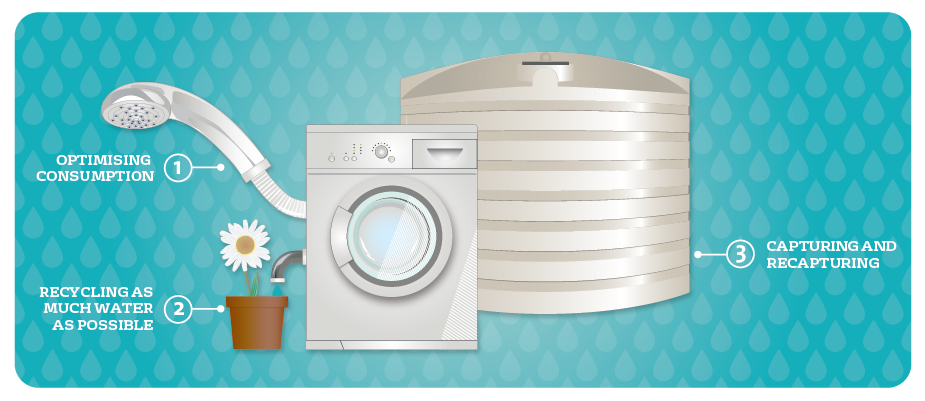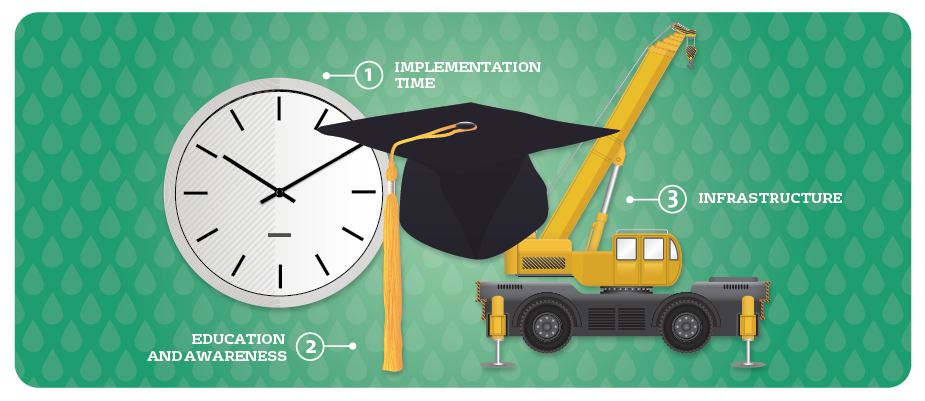
So what does net positive mean?
While ‘net positive’ is a trending phrase in sustainability, many people remain unclear about what it actually means, or more so, how to achieve it.
In simple terms, when a commercial or residential development is net positive in relation to water and/or energy for that matter, it is where they are creating more water (or energy) than they are actually using.
How can you become net positive?
There are three key ways in which a residential or commercial entity can become net positive as far as water use:

1. Optimising consumption
Optimising water use means reducing the amount you consume, either by implementing restrictive measures (such as water efficient appliances), or actively monitoring and limiting your usage.
“By optimising your water usage, you reduce the overall amount that you consume, which is probably your first duty as a good global citizen,” says Alban Delpey, Veolia’s Operational Water Manager.
2. Recycling as much water as possible
The second step towards being net positive is recycling some of the water that is used or accessed.
Recycling schemes are essential building blocks that allow businesses to become net positive. Veolia has implemented a range of water treatment facilities in Australia and around the world and has helped many organisations build on these facilities to optimise their water usage and reduce wastage.
3. Capturing and recapturing
“Capturing an extra stream of water into your cycle is a great way to bring your overall water equation onto the positive side,” says Delpey.
“Rainwater harvesting is the most obvious way of capturing water, so if a property has roof space, this is probably the simplest and most generally available technique,” adds Matthew Lee, Veolia’s Regional Energy Manager.
Stormwater can also be captured and re-used, if it’s easily accessible.
“A lot of councils are trying to capture stormwater these days using clever techniques. They are putting facilities in place so that they can store it and have access to it when required,” explains Delpey.
Why become net positive?
Currently, the movement towards becoming net positive in terms of water is only beginning, and is therefore a potentially challenging concept for both residents and commercial developers.
In contrast to the energy and power sector, as yet, there are no financial incentives or rebates in place for delivering water back into the community.
However, the concept is certainly gaining momentum. And while there aren’t yet any commercial drivers, there are lots of other benefits – largely intangible – that can come with being net positive.
“Water is worth a lot more than we value it at, and we take it for granted,” says Lee. “But the awareness and education around the value of water is getting better and better.”
According to Lee, we are simply at the beginning of a movement that is going to become very popular in years to come.
“We are seeing more theoretical articles and things happening than we were three of four years ago, and that has to flow on onto people designing and building systems to do it, then getting those up and running and actually operating,” he says.
What are the main challenges associated with becoming net positive?

As this is a relatively new area, it requires customised technology – and a key challenge can be the implementation time.
“There’s a long time between thinking about how to do it, knowing how to do it and implementing it; actually doing it. It’s not quick, it’s not at the flick of a switch,” says Lee.
Education and awareness is another challenge for early adopters. Without education and awareness regarding the value of water, there remains disconnection between human behaviour and its potential positive impact.
“I think it’s widely recognised that water is not necessarily ascribed the correct value, in terms of dollars. And that’s probably the first challenge. Not just the conceptual value, but the economic value of water is really putting us behind when we are discussing net positive, because the process is driven by the dollar,” says Delpey.
Another key challenge is the need for infrastructure – often in a shared capacity. While water re-use may be applicable on one site, it may be irrelevant to a direct neighbour, and there’s no point being net positive if there’s no-one else in the close vicinity who can use the water.
“You may have a perfect use for the recycled water where you are, but if there’s no incentive for anyone else to use it, and no opportunity to share infrastructure, then everything else falls down,” says Lee.
What needs to be done?
To drive adoption of net positive water, collaboration and cooperation is essential.
Both Lee and Delpey suggest that local councils also need to get on board – as through their infrastructure, they are capable of capturing a lot of rainwater and stormwater. While residents are the main consumers of water, the councils themselves are not.
In addition, net positive water needs to be a priority for new residential and commercial developments from the outset – in the initial design phase.
A master-planned community, for instance, or even a new set of apartments, can easily become net positive through a network of optimised consumption, optimised design that avoids water use, a robust educational offering to residents to ensure that behaviours are in synch with the technology available. A recycling system can then bring the equation closer to neutral through the use of recycled water for toilet flushing, laundry and soil irrigation, and a combination of water harvesting – rainwater, stormwater, and potentially sewer mining.
“Being water net positive has to be a holistic approach. It’s about looking at where water comes from, how it’s utilised, and the impact of taking it out of that particular source, treating it, and then putting it back in to another stream, at a different quality,” says Delpey.
“For instance, it you take water out of a river, you treat it, people drink it, you recycle and treat it, and it becomes irrigation for farms, what is the impact of that process on the environment and the economy? You have to consider it holistically,” he adds.
Veolia is pioneering and encouraging net positive water around the world – working with cities, councils, developers and regulators to try to get the conversation started.
You can also read more in our interview with the Guardian.

